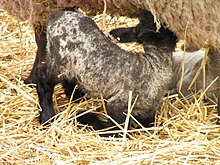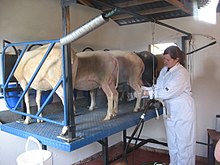Sheep milk

Sheep's milk or sheep's milk is the milk of sheep .
history
Sheep 's milk was already produced by the shepherds of ancient times. The sheep was domesticated long before the cattle , about 8,000 years ago . The Bible also speaks of sacrificial lambs: These lambs were slaughtered very early in order to be able to milk the ewe.
Sheep's milk has long been part of the human diet. Yoghurt e.g. B. was originally made from sheep's milk only; in the Caucasus and in many other regions of the world the frugal sheep were superior to the more demanding cattle.
Sheep's milk has hardly any tradition in Germany. Only in times of need were sheep (next to goats) milked as “the little man's cow”. There was a small renaissance in the early 1980s, when milk sheep became increasingly popular for self-sufficiency.
meaning
Unlike in the Mediterranean countries or in the Balkans, sheep's milk production is relatively low in Germany. Paradoxically, one of the most productive milk sheep breeds comes from Germany: on the German North Sea coast , the East Frisian milk sheep was bred more than 300 years ago , which is superior to most other sheep breeds in terms of milk yield. However, it always remained with small farms, its milk was not used commercially. In addition to a few full-time farms, there are still hundreds of hobby shepherds in Germany.
In Switzerland, the proportion of full-time farms is likely to be higher. However, only about half of the sheep's milk produced is marketed in Switzerland. At 56 percent, the majority of producers rely on ecological production .
Sheep's milk is often not marketed fresh, but z. B. processed into sheep cheese . Famous examples are the Roquefort and Brocciu from France, the Italian pecorino and the Greek feta . The Kazakh cuisine knows sheep's milk as a drink, although kumys - fermented mare's milk - is more common there. In Spain and the Basque Country , curd made from sheep's milk is known as Cuajada . In addition to jardum , the foam that is made from salted sheep's milk that is cooked with mild heat, Serbian cuisine also features the dish paprike u jardumu - peppers in sheep's milk.

Nutritional value
Sheep's milk consists on average u. a. from 18.7% dry matter, 6.8% fat, 6.0% protein and 5.0% lactose . There is 417 kJ of energy in 100 g. It also contains calcium (183 mg), potassium (182 mg), phosphorus (115 mg), sodium (30 mg) and magnesium (11 mg).
According to Jüngst 2004, this information varies depending on feeding, season and individual animal.
Medicinal effect
The fat content of sheep's milk is almost twice as high as that of cow's milk. However, the composition of the fats differs. While the proportion of cholesterol is roughly the same, sheep's milk has a multiple higher content of CLA ( conjugated linoleic acid ) than cow's milk .
The amount of vitamins is also worth mentioning: sheep's milk contains more vitamins A, D, E, riboflavin, B6, B12 and vitamin C than cow's milk. The folic acid content of sheep's milk, however, is lower.
In-depth systematic studies on the medical and biochemical mode of action and the success of targeted supplementation with sheep's milk products are still pending. These would be needed to substantiate hypotheses about the medicinal properties of sheep's milk.
Due to the similar composition, people who are intolerant to cow's milk are usually also intolerant to sheep's milk. Depending on which component of the cow's milk the intolerance is directed against, sheep milk can serve as a substitute for cow's milk intolerance in individual cases. Since sheep's milk, like all other types of animal milk, contains lactose, sheep's milk is not suitable as a substitute for people with lactose intolerance. There are very few medical studies on sheep milk intolerance.
swell
- Brigitte Kengeter: The importance of sheep's milk for human nutrition, 2004 (PDF file; 480 kB)
Web links
- Information from the teaching, testing and specialist center "Milk Analysis" Triesdorf ( Memento from April 4, 2009 in the Internet Archive )
- Articles about the ingredients and health benefits of sheep's milk.
Individual evidence
- ↑ http://www.agroscope.admin.ch/data/publikationen/1285936130_scw_Druck_de_Schaf_und_Ziegenmilchproduktion__ALP-Tagung_2010_10_01.pdf ( page no longer available , search in web archives ) Info: The link was automatically marked as defective. Please check the link according to the instructions and then remove this notice. on page 8
- ↑ Federal Statistical Office : Agricultural Structure Survey 2018 In: admin.ch , May 28, 2019, accessed on February 1, 2020.
- ↑ Brigitte Kengeter: The importance of sheep's milk ..., pages 26–32, the discussion of linoleic acid can be found on page 32
- ↑ Brigitte Kengeter: The meaning of sheep's milk ..., pp. 34–46
- ↑ Brigitte Kengeter: The meaning of sheep's milk ..., pages 24-26


